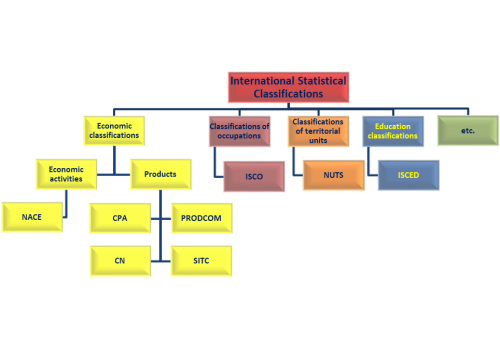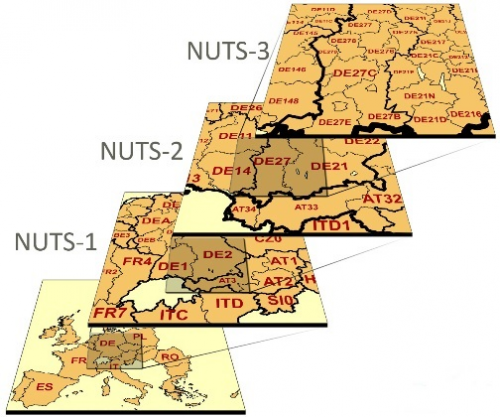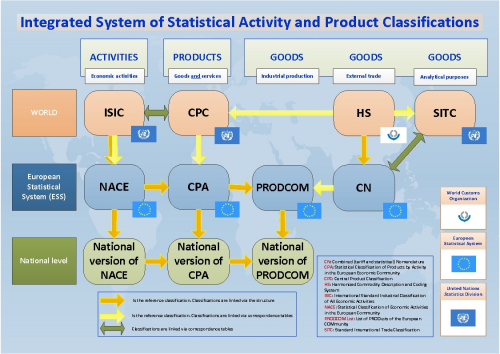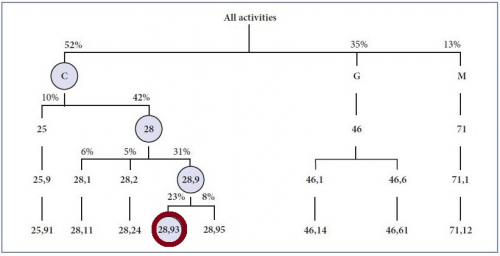Archive:European business statistics manual - classifications
This Statistics Explained article is outdated and has been archived - for updated information please see the dynamic version of the European Business Statistics Manual at: European Business Statistics Manual
A static full version of the European Business Statistics Manual was published in February 2021: European Business Statistics Manual — 2021 edition
This article provides general information on cross—domain or interconnected classifications, and some general principles. It includes a full list of individual classifications detailed in glossaries and links to those classifications. These glossaries will be completed in the second half of 2018.
This article introduces the statistical classifications used to classify business statistics by criteria such as:
- economic activity
- product/commodity
- geographical entity.
It is part of the online European Business Statistics Manual, which outlines key methodologies and metadata pertaining to business statistics.
Full article
Introduction
Classifications form the basis for collecting, compiling and disseminating data in every area of statistics. They are standardised concepts used to describe phenomena such as economic activity, products, expenditure, occupation or health. They are necessary to measure these phenomena in a consistent fashion within and across countries and geographical regions. International reference classifications set standards for internationally comparable classifications. These, in their turn, serve as models for the corresponding national, multinational and regional statistical classifications, and they form the basis for internationally comparable data.
Classification plays a central role in the statistical system as a whole. If the wrong categories are applied to the observed universe, the material supplied to decision-makers for their analysis will be of poor quality or even useless. Misclassification adversely affects the quality of statistics, thereby impinging on international comparability.
This article does not provide any detailed descriptions of the individual classifications mentioned here. For such information, please consult the glossary and the sections ‘Further Eurostat Information’ and ‘External Links’ at the end of the article, which provide links to additional resources.
What are statistical classifications, and why do we need them?
The United Nations define a classification as
- ‘a set of discrete, exhaustive and mutually exclusive observations which can be assigned to one or more variables to be measured in the collation and/or presentation of data’.
Their main purpose is ‘to simplify the real world’, thereby enabling it to be better understood. There are an estimated 50-100 million types of goods in existence. This enormous number of results is meaningless for analytical purposes, it being impossible for decision-makers to extrapolate any trends or draw any conclusions from such a huge mass of raw data.
Standard statistical classifications are needed to define and describe economic and social processes.
They systematically break down a population of entities, objects or phenomena on the basis of accepted principles and conventional criteria.
Classification means breaking down the population into parts distinguished by characteristics that do not occur in other parts, measured for the purpose of presenting statistical data.
Classifications may differ in structure. They can be:
- hierarchical (e.g. classification of activities — ISIC/NACE or products — CPC/CPA), or
- flat (e.g. gender classification).
Properly defined classifications have the following features:
- they embody methodological principles, i.e. they define the set of methods used to define the categories of the classification, and the basic rules used to implement it
- groupings are denominated by codes (numeric or alphanumeric)
- they are accompanied by explanatory notes and tables showing equivalence to other classifications or earlier versions of the same classification
- each unit (object, phenomenon) classified is unambiguously assigned to a single grouping at the appropriate level in the classification breakdown.
Family of International Statistical Classifications
Compiling the wide range of statistics produced by national and statistical organisations calls for different classifications to meet different needs. Statistical classifications can be broken down into large ‘families’, the most extensive one being the family of economic classifications.
Economic classifications break down into:
- ‘economic activity classifications’ (e.g. NACE)
- ‘product classifications’ (e.g. CPA).
A classification of economic activities is designed to categorise data that can be related to the unit of activity, for example an individual plant or group of plants comprising an economic entity such as a company. Such classifications form the basis for compiling statistics on:
- output
- production factors (labour, raw materials and supplies, energy, etc.)
- capital formation, or
- financial transactions carried out by such units.
Classifications of economic activities cover all economic activities and provide the basic categories whereby activities carried out by economic entities (companies, local units and similar statistical units) can be assigned to homogeneous categories.
A product classification provides categories for grouping products (goods and services) with shared characteristics. These provide the basis for compiling statistics on the production, consumption, foreign trade, distributive trade and transport of such products.
The other classification families provide tools to describe various other dimensions captured by statistics, such as occupations, level of education, and diseases.
The NUTS classification (‘nomenclature of territorial units for statistics’) is a hierarchical system for dividing up the economic territory of the EU in order to:
- collect, develop and standardise EU regional statistics
- conduct socioeconomic analyses of the regions
- NUTS 1: major socioeconomic regions
- NUTS 2: basic regions for the implementation of regional policies
- NUTS 3: small regions for specific diagnoses
- frame EU regional policies.
Integrated System of Economic Classifications
Most of the activity and product classifications in current international use are interconnected, either closely or loosely. This makes it easier to compare statistics produced by different institutions and covering different statistical domains. There are also rigorous interlinkages between standard classifications at world, European and national level. This system of economic classification, which is both horizontally and vertically integrated, is depicted below.
This integrated system of international statistical classifications gradually emerged during the 1980s. Global classifications developed under United Nations (UN) auspices are used as reference points to develop European Statistical System-level classifications, which, in their turn, are used as references for national versions. The reason for the existence of different standards at global, regional and national levels is that different stakeholders have different needs. For instance, the European Statistical System (ESS) often has more detailed needs than the UN, while ESS countries have specific economic activities and products that are reflected in their national classifications — olive growing in southern Europe, for example.
Though different in nature (see above for the distinction between activity and product classifications), these classifications are closely linked. Linkage is achieved either through the coding system used in the classifications or by means of correspondence tables.
It was decided at ESS level to try and link the various economic classifications via the structure rather than via correspondence tables. With only a few exceptions, this principle was implemented for NACE, CPA and PRODCOM. The 4-digit categories of NACE are thus used as a backbone for CPA, which adds 2 further codes for its specific needs (product classifications are generally more detailed than activity classifications). In turn, the PRODCOM List extends the 6-digit codes of CPA to include 2 further codes. The coding pattern can be summarised thus,
- XX.XX.YY.ZZ
where XX.XX denotes NACE codes, YY denotes CPA codes and ZZ denotes PRODCOM codes.
The national statistical offices apply the same principle to developing their national versions (if any) of these reference classifications.
Central role played by HS and CN
These two classifications provide building blocks for the ‘goods’ part (i.e. all moveable objects, materials, etc.) of product classifications.
Harmonised System (HS) and Combined Nomenclature (CN) are the world and ESS standards respectively for collecting data on external trade. But the categories of these very detailed classifications are also used as input for describing the ‘goods’ part of more aggregated classifications, such as CPA and PRODCOM. Each category of these aggregated classifications is in fact described in terms of groupings of HS/CN categories. There are several reasons why this approach was chosen:
- These classifications are very detailed (around 5 000 categories for HS, 10 000 for CN), and it was thought appropriate and cost-effective to reuse existing resources, rather than start from scratch.
- They are also (and primarily) used for tariff purposes (i.e. to establish the duties payable when goods cross borders) and are therefore subject to very stringent procedures and rules and to thorough checks by numerous expert committees. This makes them very reliable tools.
- Both classifications are accompanied by very detailed explanatory notes (about 2 000 pages for HS) as well as various other services and tools (e.g. classification decisions) which help to classify goods in the classification.
- Both classifications are revised regularly (every 5 years for HS, every year for CN), thus ensuring regular updates of the list of goods and proper alignment with economic changes.
- Both classifications (and their explanatory notes) are translated into dozens of languages, thus providing a common understanding of the content of the categories of any product classification (as regards ‘goods’ of course).
The HS/ CN coding system is as follows (with no exceptions):
- XX.XX.XX.YY
where XX.XX.XX denotes HS codes and YY denotes CN codes.
How are products and statistical units assigned to classifications?
Different methodological criteria can be used to construct classifications. So the process of assigning an item (whether a good, a service or a statistical unit) to a statistical classification depends on these methodological principles.
For CPA, the main classification criterion is industrial origin, i.e. each product is assigned to the economic activity that produces it (e.g. milk powder → milk processing, lawnmowers → production of agricultural machinery, retail trade in fuels → petrol stations). Each product must be entered under one heading only in the classification of activities; mutually exclusive categories are an essential characteristic of statistical classifications. Such product classifications therefore relate to a classification of economic activities, so that the resulting classification matches the classification of economic activities. Such a relationship exists between CPA and NACE. A distinguishing characteristic of such a system is that each product is assigned to a single industry, even though (a) the product might actually be produced by more than one industry, and (b) the industry may also produce products corresponding to NACE codes other than that of its main NACE activity.
For the harmonised system (HS) and the combined nomenclature (CN), the basic criterion is the ‘physical properties and intrinsic nature’ of the goods concerned, based on inherent criteria such as:
- the raw materials they are made of
- the stage of production they have reached
- how they are produced
- the purpose or user category for which they are intended
- whether they can be stored.
A good’s classification is thus determined primarily by its inherent features.
The way goods are produced is not necessarily the same as the industrial origin, though they very often coincide. Sometimes an industry produces goods that are totally different from each other, e.g. meat and hides, both produced by slaughterhouses. These goods are not assigned to the same category or even to the same section of a classification. For example, raw fur skins and miscellaneous raw hides and skins are considered raw animal material and classified under ‘agriculture’. Meat, on the other hand, is classified under ‘food products’.
The PRODCOM List is a special case, as its categories are part of larger CPA categories and are made up of groupings of CN categories. It thus inherits, by definition, the classification principles of both classifications to which it is linked.
The basic classification rules for the Statistical Classification of Economic Activities (NACE) are as follows: one NACE code is assigned to each unit recorded in statistical business registers, in accordance with its principal economic activity. The principal activity is the one contributing most to the unit’s value added. The following help with the assigning of the NACE code:
- NACE’s explanatory notes
- classification decisions (called case laws) taken by the NACE management committee
- correspondence tables
- reference to other classification systems, including the ISIC (United Nations classification of economic activities), CPA, HS and CN.
Value added is the basic concept that determines a unit’s classification by economic activities. It is not always possible to find out the value added associated with the various activities carried out; in such cases, activities are classified using substitute criteria. These may be based on output (e.g. the gross output of the unit that is attributable to the goods or services associated with each activity), or on input (e.g. wages and salaries attributable to the various activities).
In simple cases where a unit performs only one economic activity, its principal activity is determined by the NACE category describing that activity. If the unit performs several economic activities (other than ancillary ones), the principal activity is determined on the basis of the value added associated with each activity, using the top-down method:
- a) Identify the NACE section with the highest share of the value added.
- b) Within this section, identify the NACE division with the highest share of the value added.
- c) Within this division, identify the NACE group with the highest share of the valued added.
- d) Within this group identify the NACE class which has the highest share of value added.
Example: a unit carries out the following activities (shares in terms of value added):
The decision path will be as follows:
Categorisation of classifications for business statistics
The statistical classifications used for business statistics are listed below (the dimension observed by the classification is given in brackets):
- NACE: Statistical Classification of Economic Activities in the European Community (economic activities)
- CPA: Statistical Classification of Products by Activity in the European Economic Community (products)
- NUTS: Nomenclature of Territorial Units for Statistics (geographical entities)
- BEC: Classification by Broad Economic Categories Defined in Terms of the Standard International Trade Classification (SITC) and the Harmonised Commodity Description and Coding System (HS) (analytical economic groupings)
- Business Function: Lists Used in Statistical Surveys (analysis of value chains)
- CN: Combined Nomenclature (goods)
- EBOPS: Extended Balance of Payments Services Classification (services)
- FOS: Field of Science and Technology Classification (R&D expenditure)
- Geonom: Nomenclature of Countries and Territories for the External Trade Statistics of the Community and Statistics of Trade between Member States (geographical entities)
- IPC: International Patent Classification (patents)
- ISCED: International Standard Classification of Education (education)
- ISCO: International Standard Classification of Occupations (occupations)
- LOC: Locarno classification (industrial designs)
- MIGs: Main Industrial Groupings (analytical economic groupings)
- NABS: Nomenclature for the analysis and comparison of scientific programmes and budgets (public financing of research and development [R&D])
- NCL: Nice classification (trademarks)
- PRODCOM List: List of PRODucts of the European COMmunity (products)
- SITC: Standard International Trade Classification (goods).
In addition to the above classifications, European Business Statistics make use of classifications by size classes; these are used as one criterion to define target populations via thresholds. At the same time they are used for defining the required breakdown on the output side.
Revisions planned (as of April 2017)
- BEC, CPA, NACE, SITC: no revisions planned in the near future,
- CN and PRODCOM: annual revisions (the date of entry into force is always 1 January)
- Geonom: irregular revision schedule, depending on changes in national territories
- NUTS: irregular revision schedule, depending on changes in national territorial units. The recently revised NUTS 2016 became operational as of 1 January 2018 for data transmitted to Eurostat.
- HS: this classification, which is the backbone for CN, is revised at 5-year intervals; the most recent revision took effect on 1 January 2017. Revisions of HS can involve major changes in the structure of the CN.
Contacts
- RAMON: estat-ramon@ec.europa.eu
- NACE and CPA: estat-classifications@ec.europa.eu
- NUTS: ESTAT-Nuts@ec.europa.eu
Direct access to
- Combined Nomenclature (CN)
- Harmonized commodity description and coding system (HS)PRODCOM list
- Statistical classification of economic activities in the European Community (NACE)
- Statistical classification of products by activity (CPA)
- Statistical units for Business Statistics
- Overview of methodologies of European business statistics: EBS manual
- Legal provisions related to Classifications can be found in the following overview
- The rationale for statistical classifications, the methodological principles underpinning their construction, etc. are explained in laymen’s terms in the ‘Companion Guide to International Statistical Classifications’. This page also provides numerous links to various resources about classifications.
- Paper publication on NACE Rev. 2 with introductory guidelines (background, definitions and principles, classification rules, etc.), structure of the classification, explanatory notes, guidelines for the treatment of outsourcing, etc. For more detailed operational rules on outsourcing, see the Outsourcing Manual.
- More information about NUTS: Principles and characteristics, history of the classification, NUTS maps, correspondence tables, legislation, publications, etc.
- The classifications mentioned in this article, plus many others, can be consulted online and free of charge on RAMON, Eurostat’s server for various categories of metadata (classifications, correspondence tables between classifications, legal acts and methodological manuals relating to statistics, concepts and definitions, etc.). All methodological information relating to classifications can also be found here.




